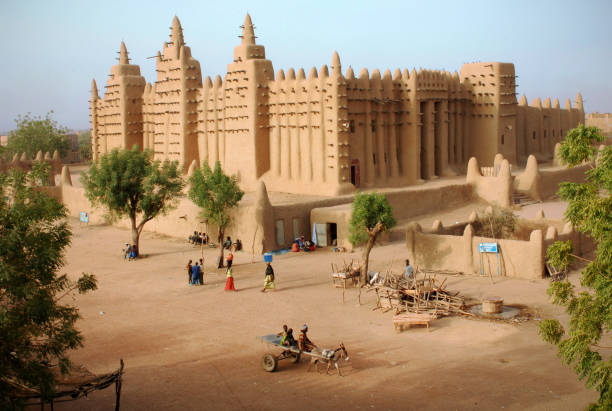A Guide On Why You Should Visit Timbuktu
If you’re anything like most people driven by wanderlust, the end of the year means it’s time to start planning your next adventure for the coming year. In this new phase of your adventure, you might be craving the fantastical desert winds of the Sub-saharan desert. The mystery adventure that comes with exploring an authentic African fabled city. If so, then travel to Timbuktu might be the right adventure for you.
For years, an air of mystery has surrounded this ancient fabled and famous city, with some people even believing it to be a mythical place that does not exist. However, we can confirm that this city rich with history, culture and beauty of the African civilization is very much a real place. It lies not far from the Niger river at the southern edge of the Sahara Desert in Mali, a country in Western Africa.
Everyone’s heard of Timbuktu. Not a lot of people actually know where it is or have been there, it’s time for you to be one of the people who go on that adventure. We’ve compiled a guide on all the reasons you should travel to Timbuktu, Mali and why a trip to Timbuktu should be at the top of your travel bucket list.
Rich History Surrounds Timbuktu
The famed history of Timbuktu dates back centuries when it was the epicenter of African civilizations. From the Mali empire to the Songhai empire, this city has always played an important role as a center of trans Saharan trade and excellence. Throughout many African civilizations. During its golden age, Timbuktu flourished from the trade of gold, ivory, salt and knowledge. Its success often piqued the interest of travelers from Europe. And it often led to so many stories and stories written about it. Much speculation about the success of the city, its gold reserves, wealth of knowledge and islamic scholarship always fascinated travelers. Around the 13th century the name Timbuktu was heard around so many corners of the world around the time as it became a story of legends and fables.
You can visit the Sankore University,
an institution which established Timbuktu as the epicenter of knowledge in Africa. It drew in scholars, explorers and historians from across Europe and Arabia. The great Timbuktu library was burnt down centuries ago. However, its valuable transcripts have been preserved by dedicated families in private collections. If you want to learn about the few precious information still left about the famous Timbuktu manuscripts, then you should visit the Ahmed Baba Institute of Higher Islamic Studies and Research. There are so many valuable historical monuments that tell the story of this once powerful empire in Timbuktu. Thankfully much of this amazing history hasn’t been polluted by the influence of modernization. So you still have an authentic experience with the history that has been preserved in this town. You will notice its ancient history as soon as you step foot on the sandy roads that lead to Timbuktu. Feeling like a brief trip back in time to some distant medieval land that almost seems still trapped in an ancient time period.
Timbuktu is home to some amazing African architecture
If you’re someone who loves to see amazing and unique architecture that dates back hundreds of years. You’re going to love the treasured architectural sites in Timbuktu. With many adobe ancient mosques and monuments built from sand mudbrick. You’ll find many structures that reflect the unique style of the Sudano-Sahelian architecture from the early 13th century. Be sure to visit the Djingareyber mosque and the home of 19th century German explorer Heinrich Barth, now a landmark known as Heinrich Barth house.
Home to UNESCO world heritage sites
Timbuktu is a UNESCO world heritage with historical sites from mosques to mausoleums that date back to the 14th century. You will have a series of options to choose from out of these ancient monuments
Timbuktu Has Welcoming Residents
One of the many reasons you’re going to enjoy Timbuktu is its friendly and welcoming residents. The resilient desert people of this small town cherish their home and its history even during hard times. They are always willing to make visitors feel welcome. The people here are also willing to help new visitors and are usually open to telling you much of the history of their town. so if you need help don’t be afraid to ask and you might be surprised at the new friends you make in the process.
Travel to Timbuktu and Experience desert life
Sand dunes surround the town of Timbuktu on the southern edge of the Sahara. It’s streets covered with sand blown in from the Sahara. It was always known as a regional trade center around the Sahara desert. So with its small mud brick houses, donkey pulled carts and camelback rides through the sandy plains. You’ll not be far from the desert experience
Experience what the rest of Mali has to offer
After you have had your adventure in the fabled city of gold. You can enjoy what the rest of Mali has to offer. And it has so many. From the amazing sites of the Hombori mountain in the south to the rushing waterfalls of Gouina and sandstone cliffs in the Bandiagara. Mali is simply an amazing country with so much history, culture and beauty to offer .
The point is,
Timbuktu is an amazing city enriched with beauty, history and lore. if you’re wondering when the best time to travel to Timbuktu is, you can visit between November and January when it’s relatively cool. Even though you might not find it to be the fabled city of gold . It still holds a magical presence with its amazing sites and people. and if you’re able to travel to this once powerful ancient city of the Mali empire, we can guarantee you’ll have a trip filled with amazing stories to tell for a lifetime. you’ll also learning a word or two from the Koyra chiini language .

